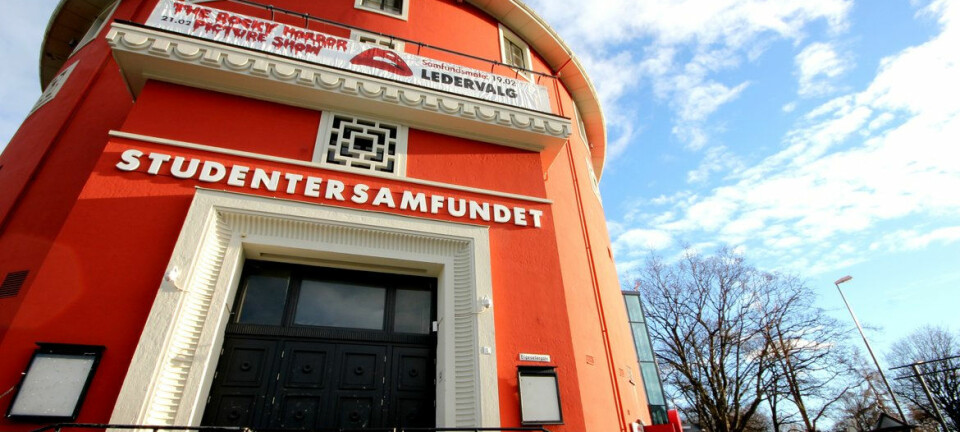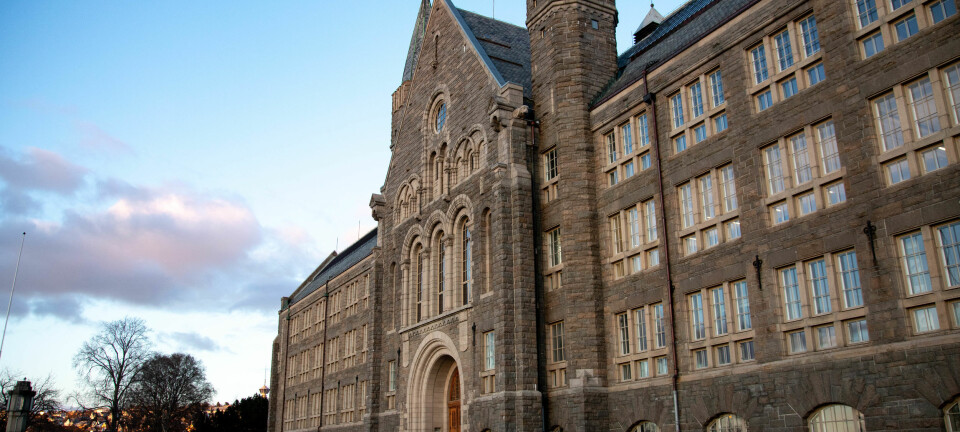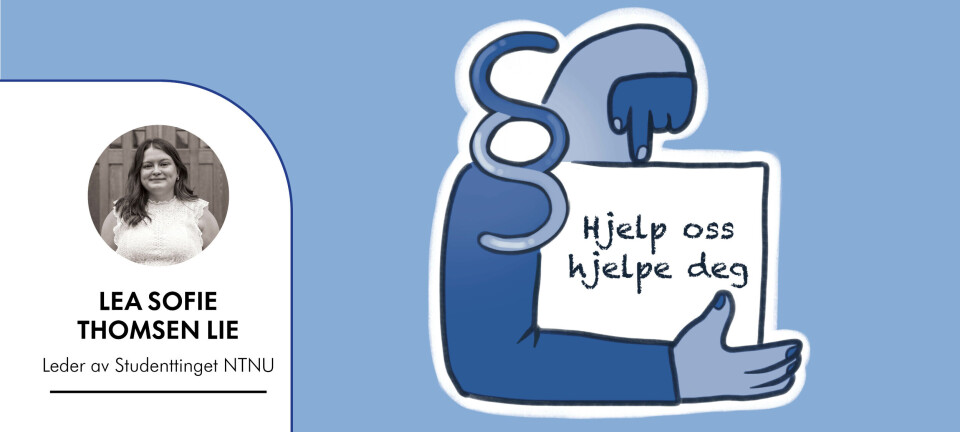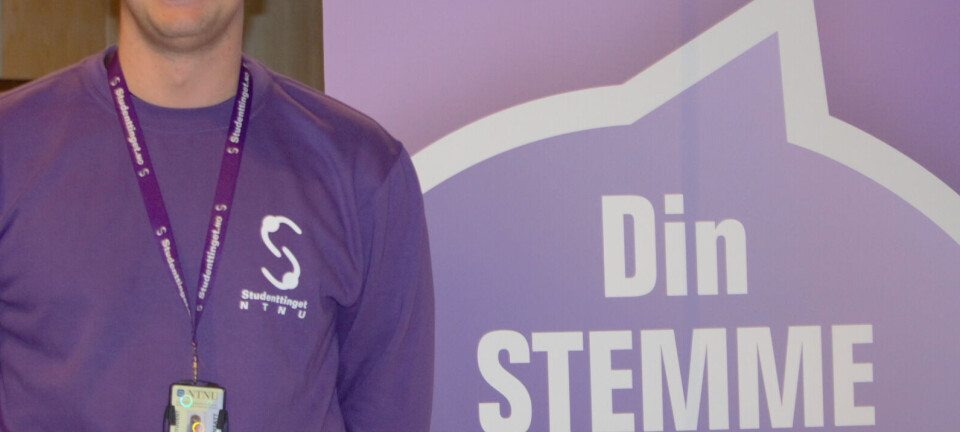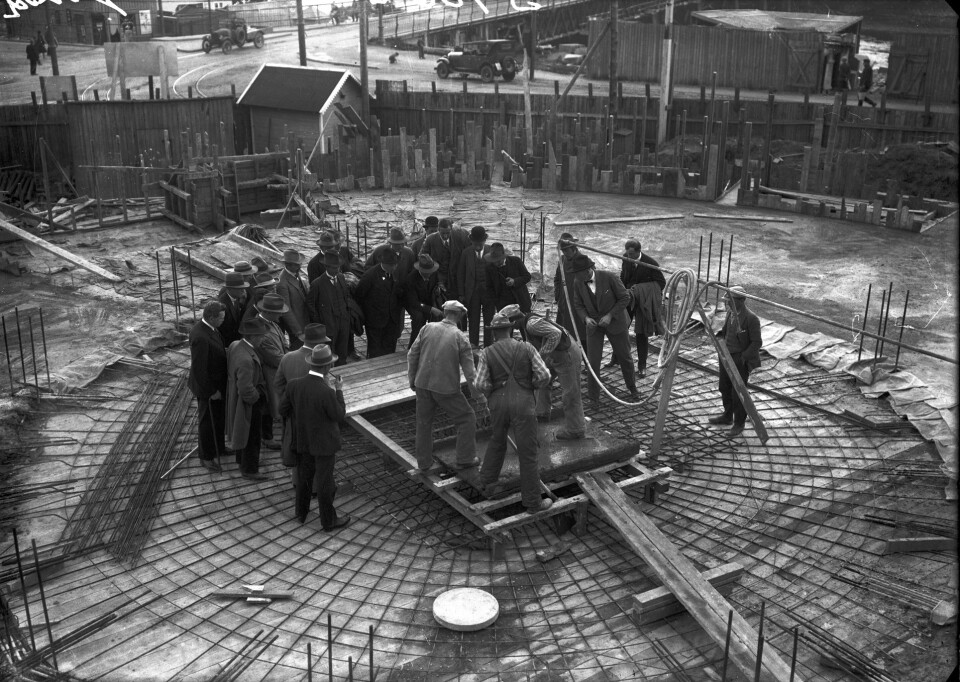
The red ruby
The students have listened to the chime of cups for 100 years. But the political pendulum of Samfundet have stopped swinging.
Tekst: Marthe Rosenvinge Ervik, Silje Løvstad Thjømøe
Translator: Tommy Lian Taraldsen
– Honoured Storsal, my name is Haakon. And I am a member.
The opening speech of H.R.H. Haakon Magnus is met by both cheers and applause. It is Friday, October 1st., and Studentersamfundet is filled to the rim by well dressed people, amongst them Minister of Education Tora Aasland, and NTNU's Head Master Torbjørn Digernes. Furthermore, the Hall is filled with dressed up gang members of all ages. Some heroes of times past, some still active in today's affairs. It is, to the day, 100 years since Studentersamfundet was made.

The first chairman of Samfundet Edgar B. Schieldrop held his speech to a audience of only men, saying «We enter this life of Society with a great burden on our shoulders, Gentlemen. Namely that of one who is to lay the foundation of a great building.» Little did he know of what was to be, and the enormous impact of this Society on tens of thousands of students. And not the least, the political voice the association would have.
The beginning
Under Dusken meets leader Mari Norman of Samfundet the day before the Jubilee. She comes hastily towards us in Daglighallen, and the entire House is practically on its head.
– It's all so chaotic. The transit from this mess to tomorrow at half past four. By then it all needs to be perfect, Mari says smiling.
– It is a fantastic feeling, I am really proud on Samfundet's behalf. Not only has it survived for 100 years, but it is just as strong and vital as it ever was. Samfundet has meant incredibly much for many students, states Mari.
20 hours later, she is at the podium in Storsalen.
– I congratulate you all! she shouts excitedly.
Mari is grateful to be able to be part of history. A history of endless hours put down by volunteers, unpaid students.

In 1910 there was no smell to speak of. In 1910 there was only an elite. And if you were a student, you were welcome to join the club. A club called The Technical College of Norway' Student's Society, and if you had your High School Diploma you were a full blooded member, regardless of whether you studied or not.
The day-to-day life of Samfundet in 1910 consisted of the Saturday meetings. Students gathered for discussions, and drank - according to professor Sem Sland - between one half and three quarters of a tankard beer per man, and was supposed to learn how to behave in formal gatherings.
– The goal of Samfundet back then was that it should strenghten comeraderie and provide proper social education. Established academics also participated, so that the students would learn the rules of the elite, author of Samfundet's jubilee book Dr. Art. Jan Thomas Kobberød.
From Royal blue to fiery red
– It took ten year from the planning began until NTH was complete in 1910, and could receive its first 103 students. It took these 103 students only 14 days before they created Samfundet, Head Master Torbjørn Digernes says.
People are laughing and applauding. What Storsalen does not know is that Digernes isn't quite right. Technically. Even though the society was formed in 1910, it did not take 14 days for Samfundet to come into form. The society first started where Circus is today in Prinsens Gate. The building in Elgsetergate wasn't started until 1922, and was finished 7 years later. It was in this time period the political aspect of Samfundet sprouted.
Kristian Gleditch founded the comunist clinic «Mot Dag» in 1927. They dominated Samfundet, and the battle between them and the left wing was strongly represented during the Saturday meetings.
Had to flee the country
When the war arrived in Norway in 1940 the political engagement changed drastically, also for the students of the Red community. A choice had to be made, and chairman Amund Hønningstad choice wrong. He is today renowned for being the most controversial chairman throughout history.
German instances insisted that Samfundet was to be put under Nazi censure, and this led to internal conflicts within the board. Hønningstad meant that it was best to accept the German demands, whilst the rest of the board refused to receive the German's suggestion. Hønningstad was forced to resign, whilst the board fled the country the following year.
The swinging pendulum
Research and Educational Minister Tora Aasland walks to the podium. She is radiating confidence, noticeable miles away. This is something she has done numerous times before. She talks about boys who want to be men, the '60s and battle between the classes. And about setting the political agenda.
– The level of conflicts that existed before the war, resurfaced in the '60s. But now the students were inspired by the cultural revolution in China and eager Marxist groups soon got a secure hold in Storsalen, Kobberød states.
In this period there was much arguing, and the political meetings at Samfundet are rarely calm. With the prime year for revolution, 1968, as a foundation, debates revolve around membership in the EEC, space travels and the occupation of the prison on Vollan. In one of the Saturday meetings in 1972, Knutsen and Ludvigsen sing about the liberation of Vietnam, and serve as a good example for the rest of the decade. The student's house is formally boiling with political engagement. In the '80s, however, the interest in politics dwindled. One of the last leaders chosen on basis of political alignment was Ingvild Valsø, leader of Samfundet autumn 1985.
– The political fronts kind of disintegrated around this time. I don't think the students were interested in having the traditional frontal politics of Samfundet any more, Valsø says.
Spring 1985 Trond Lygre ran as a representative for Venstrevind, but during his period removed himself from the party. Ingvild Valsø and her board followed his example.
– I don't think there was any political foundation for the break, but rather a result of the developments in society back then, says Valsø.
The student is devalued
– Samfundet has changed considerately the last 25 years. The focus on the house itself has taken over, together with the different groups. The political meetings have been given less meaning and Samfundet gone from being a political bastion to being defined by what is happening right now, Kobberød says.
The writer of the jubilee work further tells about how the role of the students have changed, and how this has affected the Red and Round.
– The role of the student has been devalued, in a way, because of the massive increase in sheer number of students, and they have lost their place in society as an elite group. This is definitely the most defining in the history of Samfundet. Samfundet is, as we see it, a reflection of the student, Kobberød says.
A lone wolf
The students gradually leave the hall; now other festivities await them. With the Castle's safety measures in connection with the Crown Prince's visit, there's barely any room for another student.
A student who, almost by definition, is present is Eivind Rindal. He is, perhaps, one of the most politically engaged members of Samfundet, and figures regularly on the podium with political speeches.
– This is a building that gives people the opportunity to express themselves and become properly educated, he says.
In a contribution to Under Dusken October 14th, 2009, Rindal writes the following:
«Samfundet and Storsalen have a future. I want to contribute to raise the debate, as I do every Saturday. I hope that more wish to help me, for in the end Storsalen is nothing without the members sitting in it.»
A place to meet
In autumn 1975, there were 2500 who voted at the election for leader in Storsalen. In comparison, Mari Normann won with 189 votes out of 343 in total.
– We have had a very good interest to this years intakes, so it is obvious that there are many who wish to engage. Still, it's something completely different from how things were in the '60s and '70s. Samfundet has simply become more social rather than political, Mari Norman says.
Today almost one third of the 35 000 students in Trondheim engaged in, or in the very least a member of, Samfundet in one way or another. When Samfundet first was founded, almost all the students were members.
– Today, the numbers are so great that it is difficult to find something which appeals to everyone. I think the devaluation of students is something positive, because everyone has a chance to have an education. And that is positive both for society and Samfundet, Mari says and smiles.
Samfundet has about 10 000 members, and between 1300 and 1400 of these are so called gang members, working for one of the numerous gangs existing. Norman tell us that they have to refuse several applications to these gangs every semester, simply because there is no space.
– That way, it is even more exclusive to be engaged in Samfundet today, says the leader of Samfundet.
Love
– Samfundet is my entire life, my one great love, the best thing about Trondheim. The people are magnificent and I have had so many wonderful moments, says Café- and service gang member Mari Gjengedal.
She is standing in her best gown in Storsalen, and have just witnessed this Friday's meeting. The love for the House is still just as strong. Her description is reminiscent of Truls Gjesland's, chairman in 1986 and member since 1963.
– I wouldn't have had any life had it not been for Samfundet. It has meant everything to me, Gjesland says.
A King arrives
The meeting is over. After a round on the house, the Crown Prince has to take his leave. After the impressions of the day, he could easily have been a gang member of Samfundet. Which gang would he have picked, and which concerts would he have attended?
The Crown Prince tries to smile reassuringly, to no effect what so ever.
It's been very nice to be here, it is fun to be able to participate in the celebration of Samfundet. It is important to the students in Trondheim, Samfundet pulls a lot of students to the city, H.R.H. Haakon Magnus says.
– I think it would have to be concert arrangements or PR. Or perhaps booking, he says smiling.
Spins on
A 100 year old history has left its marks. Some will say that everything has changed, others will argue that Samfundet is the same as in Schieldrop's days: Making students out of students. The political issues that once made Samfundet famous has dwindled, but the inner life and workings are better than ever. For there must be something about the Red and Round, making even the Crown Prince wanting to join.
BILDETEKSTER:
1. All power in this hall?: Neither the student mass that is gathered nor the rest of society is the same as for a hundre years ago. Still, the members of the House have something in common. Oct. 1st. old as well as new members are gathered in Storsalen.
2. In Rundhallen: Hi, my name is Haakon. And I am a member, the Crown Prince said in Storsalen a few minutes after this picture was shot. He thinks that the student life in Trondheim is known for being one of the best in Norway, and that the main cause for this is Samfundet.
3. Rollin': The red carpet is obligatory when the Crown Prince is coming to visit. Herman Westrum Thorsen and Ruben Angell of Samfundet's board is taking responsibility.
4. Genuin: Samfundet is my entire life, KSG member Mari Gjengedal says.
5. Throw's a kiss: After the meeting a private tour of the house awaited the Crown Prince, where he got to experience a private concert with the girl's choir Candiss. And some flirtation.
6. Couldn't help herself: - I think it would have to be concert arrangements or PR. Or perhaps booking, the Crown Prince gives in reply to the question of which gang he would have chosen for himself. The reporters from Dusken were more than happy with the reply.
7. All dressed up: Receiving much applause, Trondheim's Student Choir sang in Storsalen Friday evening.
8. Like waves on a rock?: The decades have been coloured by varying political strenght for Samfundet. The interest started dwindling in the 1980s. (Grafics: Lisa Landvik)





